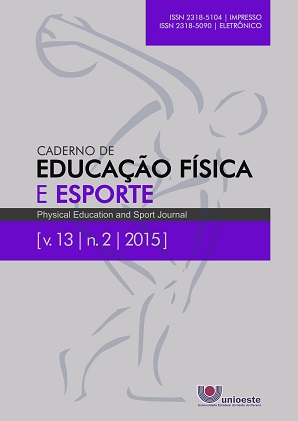A importância do professor de educação física nos anos iniciais do ensino fundamental
DOI:
https://doi.org/10.36453/2318-5104.2015.v13.n2.p97Palavras-chave:
Educação Física, Formação Professional, Ensino Fundamental.Resumo
O projeto “Educação Física para os anos iniciais do Ensino Fundamental: uma proposta de inserção social através de atividades motoras”, parte do Programa “Universidade Sem Fronteiras”, foi desenvolvido em duas cidades do oeste do Paraná com baixo IDH (índice de desenvolvimento humano), em que as aulas de educação física passaram a ser ministradas por professores graduados. O objetivo deste texto foi mostrar a importância do professor de educação física ministrar as aulas para os anos iniciais do ensino fundamental, levando em conta a experiência que foi realizada nesses municípios. A metodologia do programa se orientou para duas vertentes: primeira avaliar os alunos através de testes motores padronizados e, em segunda, avaliar pais, diretores, professores e alunos participando do projeto por meio de questionários. Os resultados dos testes de habilidades motoras para driblar, arremessar e chutar, assim como outros testes motores para o equilíbrio, esquema corporal, organização espacial e habilidades motoras finas e grossas mostraram que ao fim do programa as crianças melhoraram as suas habilidades desde o início do projeto. Os resultados dos testes motores e as respostas dos questionários mostrou que as crianças melhoraram tanto as suas habilidades motoras básicas, bem como os seus aspectos emocionais, sociais, cognitivos, depois que começaram a ter aulas com professores de educação física durante o projeto.
Downloads
Referências
ALBERTI, H.; ROTHENBERG, L. Ensino de jogos esportivos. Rio de Janeiro: Ao Livro Técnico, 1986.
ALVES-MAZZOTTI, A. J. O método nas ciências sociais. In: ALVES-MAZZOTTI, A. J.; GEWANDSZNAJDER, F. O método nas ciências naturais e sociais: pesquisa quantitativa e qualitativa. São Paulo: Pioneira Thomson Learning, 2001.
AMOP. Associação dos Municípios do Oeste do Paraná. Departamento de Educação. Currículo básico para a escola publica municipal: educação infantil e ensino fundamental – anos iniciais. Cascavel: Assoeste, 2007.
ANDRÉ, M. D. A. A pesquisa no cotidiano escolar. In: FAZENDA, M. (Org.). Metodologia da pesquisa educacional. São Paulo: Cortez, 2001.
BERSCH, A. R.; MACHADO, B.; RUDEK, E.; MORAIS, L. O.; RECALCATTI, L.; BARBOSA, M. A.; SCHARAM, S.; SCHIMIDT, S. M. S. Proposta de educação física para a pré-escola, primeira e segunda séries do primeiro grau. In: BRANDL NETO, I. (Org.). Educação física nas séries iniciais. Toledo: EdT, 1996. p. 49-78.
BRANDL NETO, I.; ALVES, C. M. M. K. Jogos competitivos e cooperativos: um estudo nas escolas municipais de Cascavel. Caderno de Educação Física, Marechal Cândido Rondon, v. 7, n. 12, p. 33-40, 2008.
BROTTO, F. O. Jogos cooperativos: o jogo e o esporte como um exercício de convivência. Santos: Projeto Cooperação, 2002.
CAPON, J. Propostas de atividades para educação pelo movimento. São Paulo: Manole, 1989.
COSTE, J. C. A psicomotricidade. Rio de Janeiro: Zahar, 1981.
DE MEUR, A.; STAES, L. Psicomotricidade: educação e reeducação. São Paulo: Editora Manole, 1989.
FONSECA, V. Psicomotricidade. São Paulo: Martins Fontes, 1983.
FREIRE, J. B. O jogo: entre o riso e o choro. Campinas: Autores Associados, 2002.
FREIRE, J. B. Educação de corpo inteiro. 2. ed. São Paulo: Scipione, 1991.
FERREIRA NETO, C. A. Motricidade e jogo na infância. Rio de Janeiro: Sprint, 1995.
GALLARDO, J. S. P.; OLIVEIRA, A. A. B. ARAVENA, C. J. O. Didática de educação física: a criança em movimento, jogo, prazer e transformação. São Paulo: FDT, 1998.
GALLAHUE, D. L.; OZMUN, J. Compreendendo o desenvolvimento motor: bebês, crianças, adolescentes e adultos. São Paulo: Phorte Editora, 2005.
GRESPAN, M. R. Educação física no ensino fundamental: 1° Ciclo. Campinas: Papirus, 2002.
KUSIAK, S. Educação física nas séries iniciais do ensino fundamental e suas práticas pedagógicas em dez municípios da microrregião de Cascavel – Paraná. 2009. 69f. Monografia (Especialização em Educação Física Escolar) - Universidade Estadual do Oeste do Paraná, Educação Física, Marechal Cândido Rondon, 2009.
LE BOULCH, J. Educação psicomotora. Porto Alegre: Artes Médicas, 1987.
MARTINS, J.; BICUDO, M. A. V. A pesquisa qualitativa em psicologia. São Paulo: Moraes - EDUC, 1989.
MATTOS, M. G.; NEIRA, M. G. Educação física infantil: construindo o movimento na escola. Guarulhos: Phorte Editora, 1999.
MANOEL, E. J. Aspectos básicos do desenvolvimento motor: implicações para a Educação Física infantil. Boletim Técnico de Educação Física e Desportos, Manaus, v. 20, n. 36/37, p. 12-35, 1985.
MELLO, A. M. Psicomotricidade, educação física e jogos infantis. São Paulo: Ibrasa, 1989.
NEGRINE, A. O ensino da educação física. 2. ed. Rio de Janeiro: Globo, 1977.
NEGRINE, A. Educação psicomotora: a lateralidade e a orientação espacial. Porto Alegre: Palloti, 1986.
NEGRINE, A. Corpo na educação infantil. Caxias do Sul: EDUCS, 2002.
PARANÁ. Secretaria de Estado da Educação. Currículo básico para a escola pública do Estado do Paraná. Curitiba, SEED, 1990.
ROSA NETO, F. Manual de avaliação motora. Porto Alegre: Artmed, 2002.
SANTIN, S. Da alegria do lúdico a opressão do rendimento. Ijuí: Unijuí, 1994.
TANI, G.; MANOEL, E. J.; KOKUBUN, E.; PROENÇA, J. E. Educação física escolar: fundamentos de uma abordagem desenvolvimentista. São Paulo: EPU, 1988.
VAYER, P. A criança diante do mundo. Porto Alegre: Artes Médicas, 1986
Downloads
Publicado
Como Citar
Edição
Seção
Licença

Este trabalho está licenciado sob uma licença Creative Commons Attribution-NonCommercial-ShareAlike 4.0 International License.
Os direitos autorais permitem descarregar, compartilhar, copiar, distribuir, adaptar, transformar, exibir, reproduzir a totalidade ou partes do artigo para qualquer propósito legal, desde que não tenha fins lucrativos e seja citada a fonte.
Informamos que todo o conteúdo do texto publicado, e dos seus possíveis erros ortográficos e gramaticais, é de inteira responsabilidade de seus autores, não cabendo ao Caderno de Educação Física e Esporte, ou aos nossos Avaliadores Ad Hoc, por qualquer implicação legal ou por eventual negligência à língua portuguesa ou à estrangeira.






















